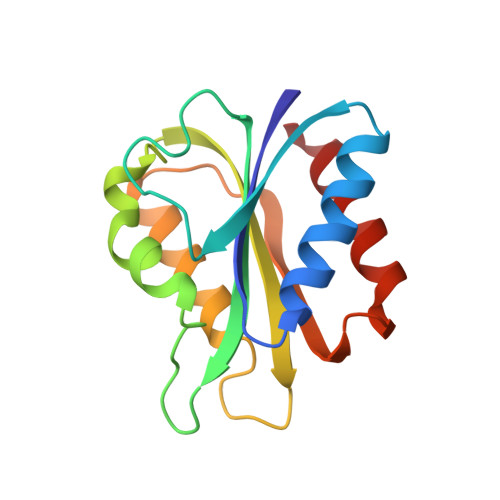Comparison of the crystal structures of a flavodoxin in its three oxidation states at cryogenic temperatures.
Watt, W., Tulinsky, A., Swenson, R.P., Watenpaugh, K.D.(1991) J Mol Biol 218: 195-208
- PubMed: 2002503
- DOI: https://doi.org/10.1016/0022-2836(91)90884-9
- Primary Citation of Related Structures:
2FX2, 3FX2, 4FX2, 5FX2 - PubMed Abstract:
The focus of this study has been to determine the conformation of the holoprotein of recombinant flavodoxin from Desulfovibrio vulgaris with the FMN in each of its three oxidation states. The structures of the oxidized state of the wild-type flavodoxin at 2.0 A from D. vulgaris was used as a starting model for refinement. Diffraction experiments were conducted at low temperature (-150 degrees C) in order to maintain the oxidation state of interest throughout the intensity data collection. yellow bipyramids by the standard hanging-drop method from 3.2 M-ammonium sulfate in 0.1 M-Tris-HCl buffer at pH 7.0 with protein concentrations ranging from 0.7% to 0.9%. The reduced states of the crystals were achieved through the addition of sodium dithionite at pH 7.0 for the semiquinone (semi-reduced) and at pH 9.0 for the hydroquinone (fully reduced). Data sets consisting of one at room temperature (oxidized state) and three at low temperature (each oxidation state) were collected on a Nicolet P3F/Xentronics area detector X-ray diffractometer system. The four structures, hydroquinone at 2.25 A resolution and all others at 1.9 A resolution, were refined by the restrained parameter least-squares program PROLSQ. The final crystallographic R-values converged to 0.21 (hydroquinone), 0.20 (semiquinone), 0.20 (oxidized, low temperature), and 0.17 (oxidized, room temperature). The reduced states of flavodoxin show a different conformation of the protein polypeptide chain (Asp61-Gly62) in the vicinity of NH(5) of the isoalloxazine group relative to the oxidized state. However, there are only slight conformational differences between the semiquinone and hydroquinone states. In this report, structural comparisons of the three are made, with particular emphasis on the features that might be related to the difference in temperature of the diffraction data collections and differences in the oxidation state of the FMN.
Organizational Affiliation:
Physical and Analytical Chemistry, Research Upjohn Co., Kalamazoo, MI 49007.















